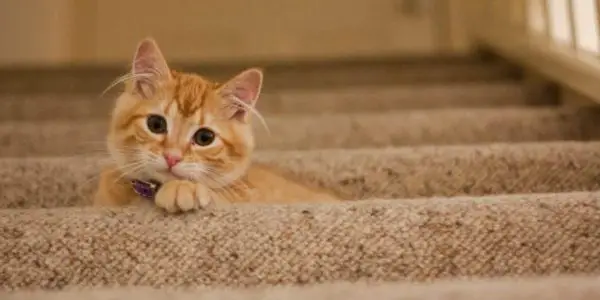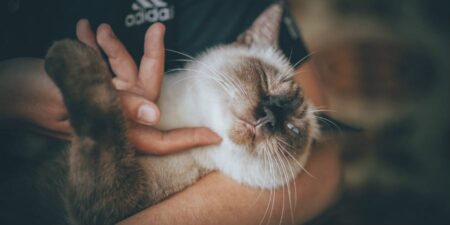Are you frustrated by your cat’s refusal to use the litter box and opting for the carpet instead? The thought of cats doing this out of spite or anger towards their humans may cross your mind. However, the reality is quite different – when cats choose an alternative to the litter box, it’s a sign that something is obstructing their access to it.
Litter pan issues are among the primary reasons for cats being surrendered to shelters. Contrary to what some may believe, it’s not the cat’s fault. Imagine this: if a cat cannot reach the litter box or make it there in time, they genuinely have no other choice but to relieve themselves wherever they happen to be.
Understanding the factors preventing your cat from using the litter box can help resolve the problem and create a more harmonious living situation for you and your feline companion.
How Old Do Kittens Need to Be Before They’re Litter Trained?
If the feline offender is a young kitten, the kitten may not know the litter box is the best place to go. Kittens learn at their own pace, but most learn in days. Cats naturally like to scratch in loose, absorbent material to cover up their wastes.
Kittens as young as three weeks old use a litter box if Mom shows them what to do. Like toddlers, kittens are prone to accidents. Simply pick them up, and plop them in the litter pan whenever they are caught squatting, and they soon get the idea.
[amazon bestseller=”cat litter box”]
5 Reasons Why Cats Won’t Use the Litter Box
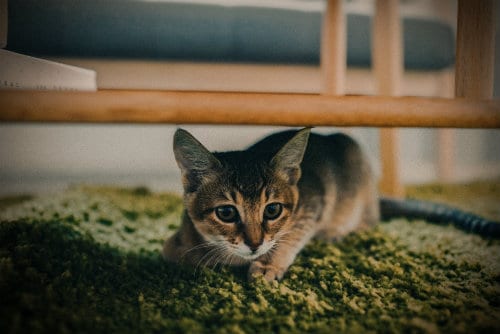
In order to fix your cat’s toileting problem, you need to identify what is causing your cat to not reach the litter in time. These reasons could include:
- Health reasons
- Territorial marking issues
- Problems with the litter box itself
- Problems with where the litter box is placed
- Emotional upset or fear at some sort of change.
It may take a while to identify the cat’s specific problem. Be patient and do not hit or yell at the cat for using the carpet as a cat toilet. He or she cannot help it.
1. Health Reasons
Get the cat checked out by a veterinarian as soon as possible. Cats suffer from many medical conditions that cause incontinence. If a cat suddenly has an accident after using the litter box faithfully for a long time, then the cat may be sick.
Medical problems that cause incontinence issues in cats include but are not limited to:
- Arthritis
- Being declawed
- Urinary tract infections
- Bad reactions to a new medication or food
- Dementia in old cats
- Tumors – whether cancerous or benign
- Diabetes – a diabetic cat is usually very thirsty as well as incontinent
- Epilepsy or something else that causes seizures
- Being overweight.
[amazon bestseller=”Cat Litter Scoop”]
A Special Note for Longhaired Cat Owners

Longhaired cats try to keep themselves clean but often cannot thoroughly wash under their tails because of their long, thick hair. Urine and poop sometimes get caught in the hair and dragged about accidentally. This may make it seem like the cat deliberately uses the carpet as a litter pan.
Unless the cat is a show cat, keep the hair under the tail and the tops of the hind legs trimmed. Check the area every day and bathe or spot-clean with a wet soft cloth when necessary. Really soiled cats need a bath – whether they like it or not.
2. Territorial Marking
Unneutered cats, especially males, are obsessive about territory, even when they live indoors alone. In order to claim a place as theirs to all the other cats in the world, they spray. Spraying is when a cat uses very strong-smelling urine to claim a place as his.
Neutering eliminates this behavior if the cat is young. Older cats get in the habit, and it can be hard to break. Sometimes females spray, but this is rare.
3. Problems with the Litter Box
Cats don’t ask for much in a litter box, but they like one that’s large enough. Small litter boxes sold for kittens are not large enough for adults. Keep a litter box on each floor of the home to offer cats a lot of clean, inviting litter.
Clean litter pans as often as possible — at least once a day. Just as people do not like using a used toilet, cats hate using a dirty litter box. Keep at least two litter boxes per cat in a household so a clean pan is always available.
Wrong Kind of Litter Box
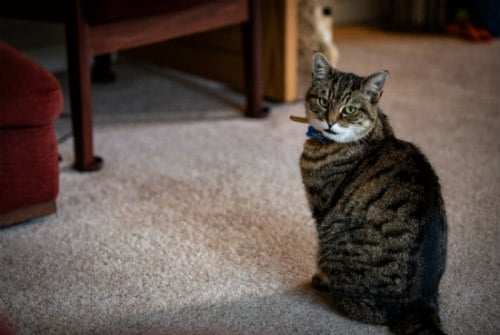
Once upon a time, litter boxes were all alike. Now there are litter boxes with covers and litter boxes that automatically clean themselves. Cats often don’t appreciate these changes.
If a cat is used to one kind of pan, changing it will cause the cat to pee elsewhere. Covers and automatically cleaning litter boxes often scare cats. A cat scared of a litter box will never use it.
4. Problems Placing the Litter Box
Cats won’t go just anywhere, no matter how often the litter is changed. Never place a litter box next to the cat’s food. People hate eating next to a used toilet, and so do cats.
Cats resemble Goldilocks in that when it comes to their litter box, everything has to be just right. Cats do not like litter boxes placed:
- In drafts
- Next to heaters or heating vents
- In very noisy or busy areas of the home.
[amazon bestseller=”tidy cats litter”]
A Special Note for Owners of Arthritic Cats
Cats suffering from arthritis often cannot lift their legs up over the litter box edge to get in. It just hurts too much. If the cat is peeing on the carpet right next to or in the same room as the box, then arthritis could be the culprit./p>
Buy a litter box with a very low rim or cut the edges of one side down so the cat will more easily get in and out of the box. Experiment with different litter pans to see which is easiest for the cat to handle.
5. Emotional Problems, Upsets, or Fear

A sudden change in the household, like bringing home a new pet or a baby, will often make a cat hide and then be afraid to come back out. He or she is too scared to use the litter pan. Give the cat a few days to adjust before calling the vet to see if there is a medical complication.
Indoor cats often get upset by seeing stray cats out the window. They can get so worked up that they lose control of their bladders. Try blocking the cat’s access to the window to see if this helps the problem.
Cleaning up Accidents
It’s important to clean up accidents the right way, or the cat will keep coming back to the same spot to use it as a toilet. If the area smells like urine in any way, then the cat will think the area makes a great cat toilet.
Clean the spot with an enzymatic cleaner specifically made for pet messes. Never use ammonia, bleach, or any cleaner that contains either of those two products. Ammonia and bleach smell like urine to a cat.
[amazon bestseller=”cleaning cat urine”]
Blocking the Cat’s Access to the Carpet
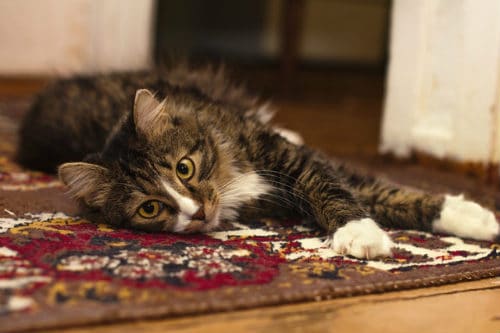
It may take days, weeks, or months before a cat owner gets a diagnosis of why the cat is not using the litter box. In the meantime, make the carpet as uninviting for the cat as possible so he or she will not want to use it as a litter box.
Place sticky double-sided tape on the carpet edges and the spots where the cat likes to pee. Cats hate the feel of the tape. Turn the carpet runners and any small rugs over because it will feel uncomfortable to the cat’s paws.
A Special Note for Owners of Declawed Cats
Declawed cats have sensitive paws where their claws were removed. Regular granulated litter hurts these cats. These cats need softer litter, such as clumping litter or litter made from old newspapers.
Declawed cats cannot fight like cats with claws can. This often makes them targets for teasing by other cats or dogs in the household. They might prevent the declawed cat from getting to the litter box.
When All Else Fails
If you’ve followed all of these steps but your cat is still peeing on the carpet, place a litter box at the spot where the cat goes most often. That works for some cats.
[amazon bestseller=”cat automatic litter box”]
If the cat still avoids the litter box when it is in a favored spot, try substituting carpet scraps for kitty litter. Some cats are so used to going on carpet that they cannot be convinced otherwise. If the cat consistently goes in one place, then carpet scraps for litter are a good compromise.
How to Stop a Cat from Urinating on a Rug (Video)
9 Related Questions About Cats and Litter Boxes
1. What types of litter box designs might cause a cat to avoid using it?
Cats may avoid using litter boxes with covers, automatic cleaning features, or those that are too small for their size. Some cats may also be resistant to sudden changes in the type of litter box they are used to.
2. How do you properly clean up after a cat’s accident to prevent future issues?
Use an enzymatic cleaner specifically designed for pet messes to clean up properly after a cat’s accident. Avoid using ammonia, bleach, or cleaners containing these substances, as they can smell like urine to a cat and encourage repeated soiling.
3. How can you make the carpet less appealing for your cat to use as a toilet?
Make the carpet less appealing by placing the double-sided sticky tape on the edges and spots where the cat likes to urinate, turning carpet runners and small rugs upside down, or blocking access to the area altogether.
4. What measures can you take to help a declawed cat with litter box issues?
For declawed cats, provide softer litter options like clumping litter or litter made from recycled newspapers. Also, ensure other household pets are not bullying the cat, preventing them from accessing the litter box.
5. How can emotional stress or fear impact a cat’s litter box habits?
Emotional stress or fear can cause a cat to hide and avoid using the litter box, leading to accidents. Changes in the household, such as new pets or babies, or exposure to stray cats outside, may trigger anxiety-induced litter box avoidance.
6. Are there any specific challenges longhaired cats face when it comes to litter box use?
Longhaired cats may have difficulty keeping themselves clean due to their thick fur, leading to urine and feces getting caught in their hair. Regular grooming and trimming of hair around their hind legs and tail can help alleviate this issue.
7. How can territorial marking issues lead to cats urinating outside the litter box?
Territorial marking issues, especially in unneutered cats, can cause them to spray strong-smelling urine to claim a space as theirs. This behavior can result in cats urinating outside the litter box in an attempt to mark their territory.
8. What is the ideal placement for a litter box to encourage use by your cat?
The ideal placement for a litter box is away from the cat’s food, drafts, heaters, heating vents, and noisy or busy areas of the home. Providing multiple litter boxes in a multi-cat household or across multiple floors can encourage use.
9. When should you consider alternative solutions, such as placing a litter box at your cat’s preferred spot?
Consider alternative solutions when you’ve exhausted other options, such as addressing medical issues, litter box design, or emotional stress, and your cat still consistently avoids the litter box. Placing a litter box at the preferred spot or using carpet scraps as litter can be a compromise for some cats.
"In ancient times cats were worshipped as gods; they have not forgotten this."
-- Terry Pratchett

